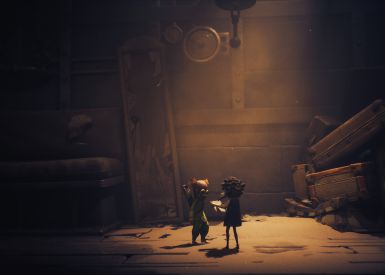Kabaneri of the Iron Fortress is a brutal, high-octane original anime from Tetsuro Araki, the series director of Highschool of the Dead, Attack on Titan, and Death Note. So what do these three series contribute to Kabaneri of the Iron Fortress ? Respectively: gorey zombies, everything, and sheer butt-rattling drama.
Let me start with the contribution of Attack on Titan, namely, “everything.” By “everything,” I mean that Kabaneri literally feels like someone’s Attack on Titan fanfiction magnum opus, some 300,000 word behemoth original alternate universe effort that’s only listed in the Attack on Titan section to gain extra readers.
Instead of Titans, you have Kabane, glowing steampunk zombies whose hearts must be pierced by iron before they’ll stop moving. Instead of humanity retreating to three last walled cities, you have walled stations, all linked by a massive steampunk train line. Instead of the Scouting Legion, you have the bushi guards. Instead of a deliberately uncertain era with mix-and-match anachronistic technology, you have a post-apocalyptic Industrial Revolution.
But wait, there’s more! Instead of Eren transforming into a Titan through blood and pain, our main man Ikoma resists the kabane virus through grit, wit, and will… and blood and pain. Instead of Eren being an inexperienced and naive youth determined to join the Scouting Legion, Ikoma is already a skilled technician who takes the bushi to task for their homicidal cowardice and works on his own time to find a new way to combat the kabane threat. Both series have oppressive, deadly politics and humans trampling over one another in the fight for survival. Society swiftly abandon the lost, making choices so harsh it seems to call into question whether humanity even deserves to survive anymore.
The zombies themselves - the titular kabane - are legitimately terrifying. They glow in the endless night, they swarm in great speed and numbers and they scream as though somehow aware of their own tormented existence. In the stomach-churning opening scene, a kabane almost wrenches a woman’s hair off their scalp. The brutality arches into physical horror in a way that Attack on Titan rarely manages with much finesse (I can’t be the only person who kind of laughed when Eren’s mom got chomped on). The kabane pass on their virus (which Ikoma furiously notes is not a curse passed down by some uncaring supernatural entity to punish humanity, but instead a malady that can be combated and even remedied) through their gorey bites.
The fear of the kabane bite causes people to carry Suicide Bags – a type of bomb placed directly over the heart, killing instantly – and strictly enforce their use before the kabane transformation takes place. When trains pass from one station to the next, they are boarded and all parties stripped naked for a dehumanizing inspection under the need to check for marks of the kabane bite. Kabaneri hints at an oppressive, vaguely Edo-era hierarchy ostensibly founded on the need for order to ensure survival, a society with little room for those who question.
As for sheer, butt-rattling drama, there’s scarcely a lull in the entire first episode. You’ve got screaming, crying and life-and-death choices within the first five minutes of Kabaneri, and it doesn’t let up. This relentless push forward works great – after all, when the premise is “Attack on Titan but with Edo period steampunk and zombies,” why on Earth would you want to wait for it? Kabaneri delivers what’s promised on the tin instantly and in a most gratifying way, with appropriate (non-stop) pacing for a world whose stakes are so perilously high. It’s unbelievable how high the tension can stack in 25 minutes. And you get two crowning moments of awesome from two different characters already, although it’s only episode 1.
It’s astonishing how effective those moments are given how recently you’ve met the characters, but there’s just something about Kabaneri. We spend lots of time with Ikoma and understand his frustration and his drive instinctively, cheering his astonishing bravery, but although we spend much less time with the little girl and the princess-type, they are both wreathed with such mysterious appeal that we’re ready for root for them too. Maybe it’s the beautiful design work, but the craving to understand more of these characters – and oh hell yes, see them in action – is enormous.
Kabaneri’s look hearkens back to older anime, with thickly-lashed eyes and stocky builds and a grittier, retro feel in its character designs that perfectly suit its subject matter and really make it stand out this season. The animation is buffed and polished to a shine, with old school hazy glows on certain people’s eyes and hair, especially in dramatic moments. There’s some CGI, most notably on the big iron trains, but it’s actually unobtrusive. Otherwise the show’s detail and beauty is cinematic in quality. Kabaneri is one of the best-looking shows this season.
Should you watch Kabaneri of the Iron Fortress?
Kabaneri of the Fortress is only available on Amazon Prime, which comes with a $99 annual membership fee. But damn, what a title to draw the anime fans in with! It is everything I wanted from Attack on Titan but didn’t know I wanted until it was so generously given to me. If the rest of the series can maintain the excitement and energy of episode 1, Kabaneri will easily be one of the best shows this season. And considering everything else an Amazon Prime subscription gets you, I would (and do) shell out for it.
Kabaneri of the Iron Fortress streams every Thursday on Amazon Prime here.


![Best Gaming Mouse For Gamers With Smaller Hands [2025]](https://d.player.one/en/full/227430/best-gaming-mouse-gamers-smaller-hands-2025.png?w=380&h=275&f=fdcf47c1c5fc58d1e41d3be505c12568)















